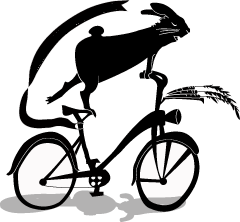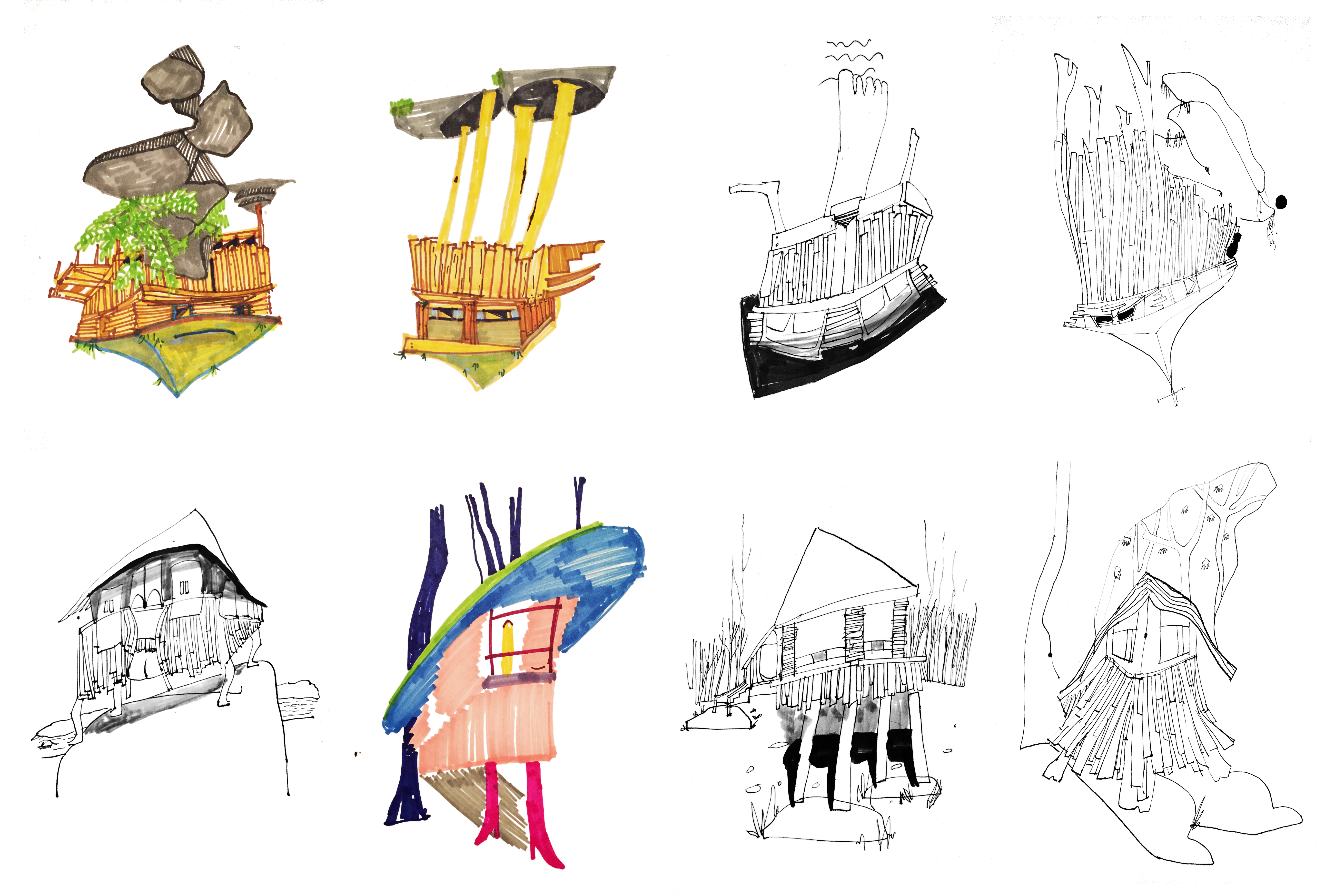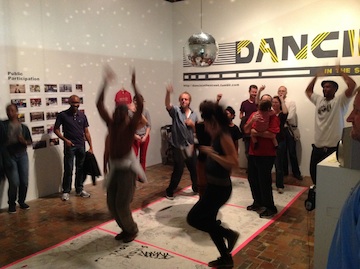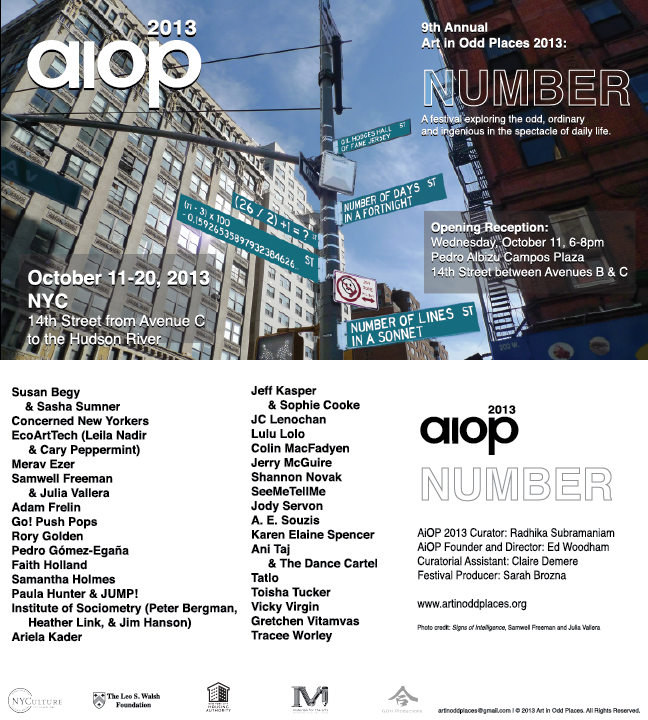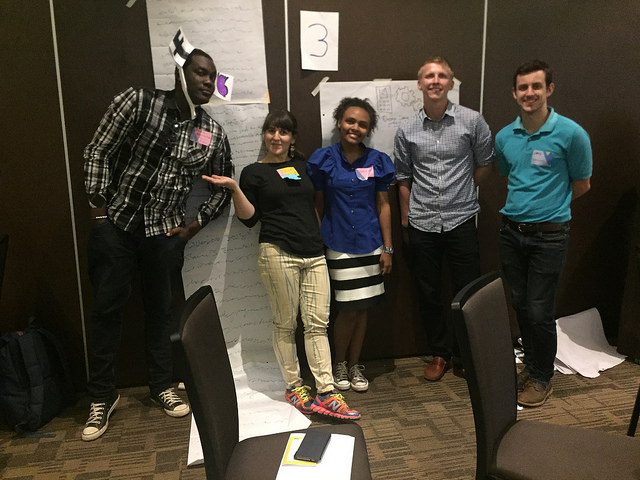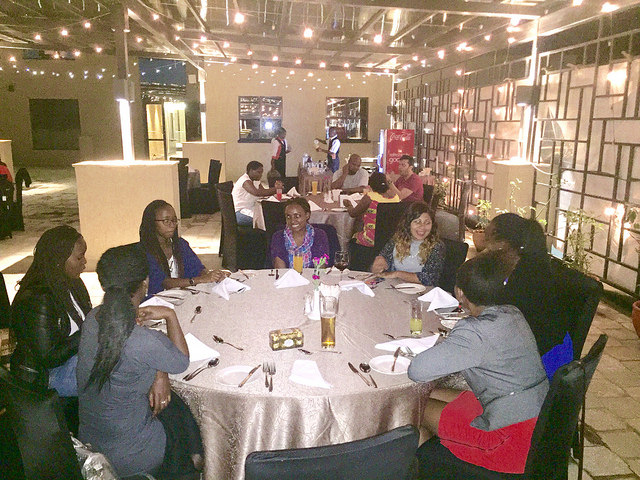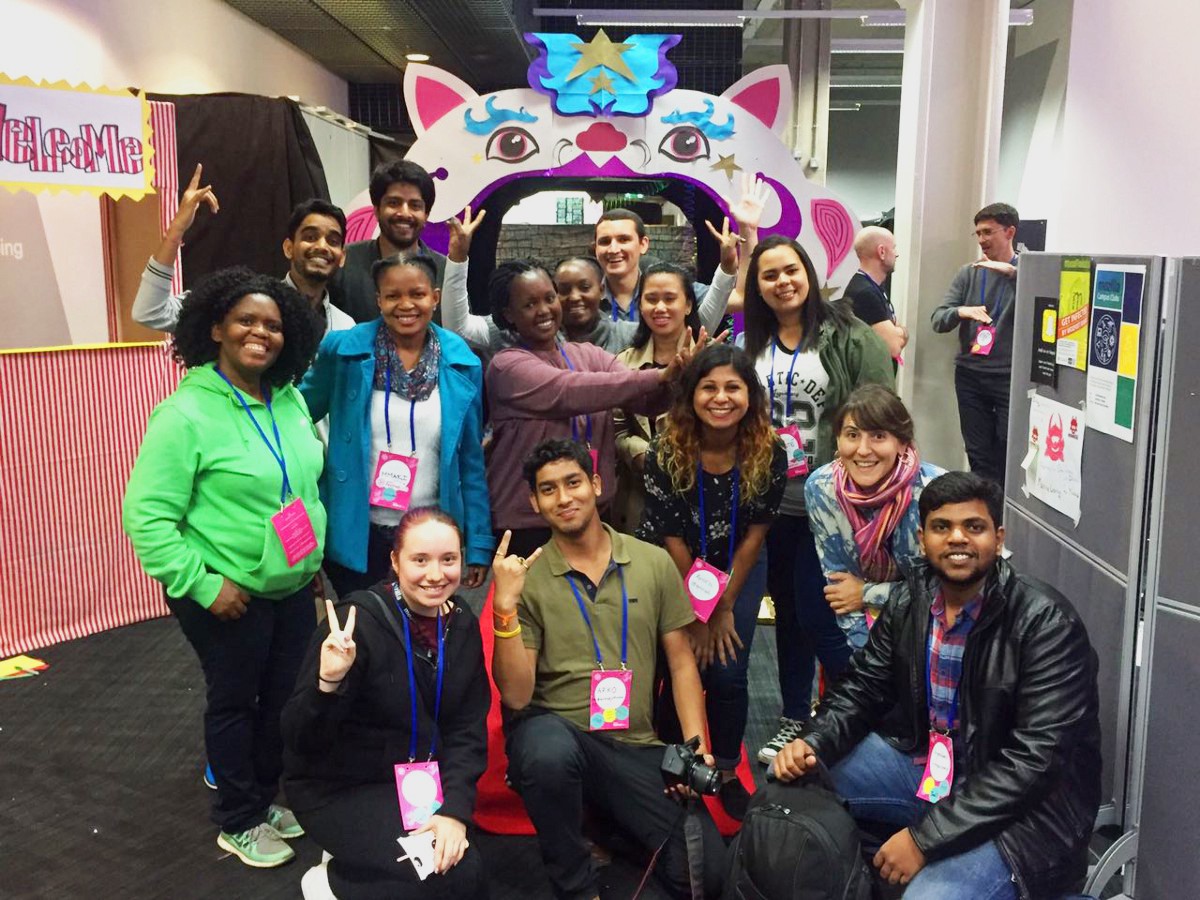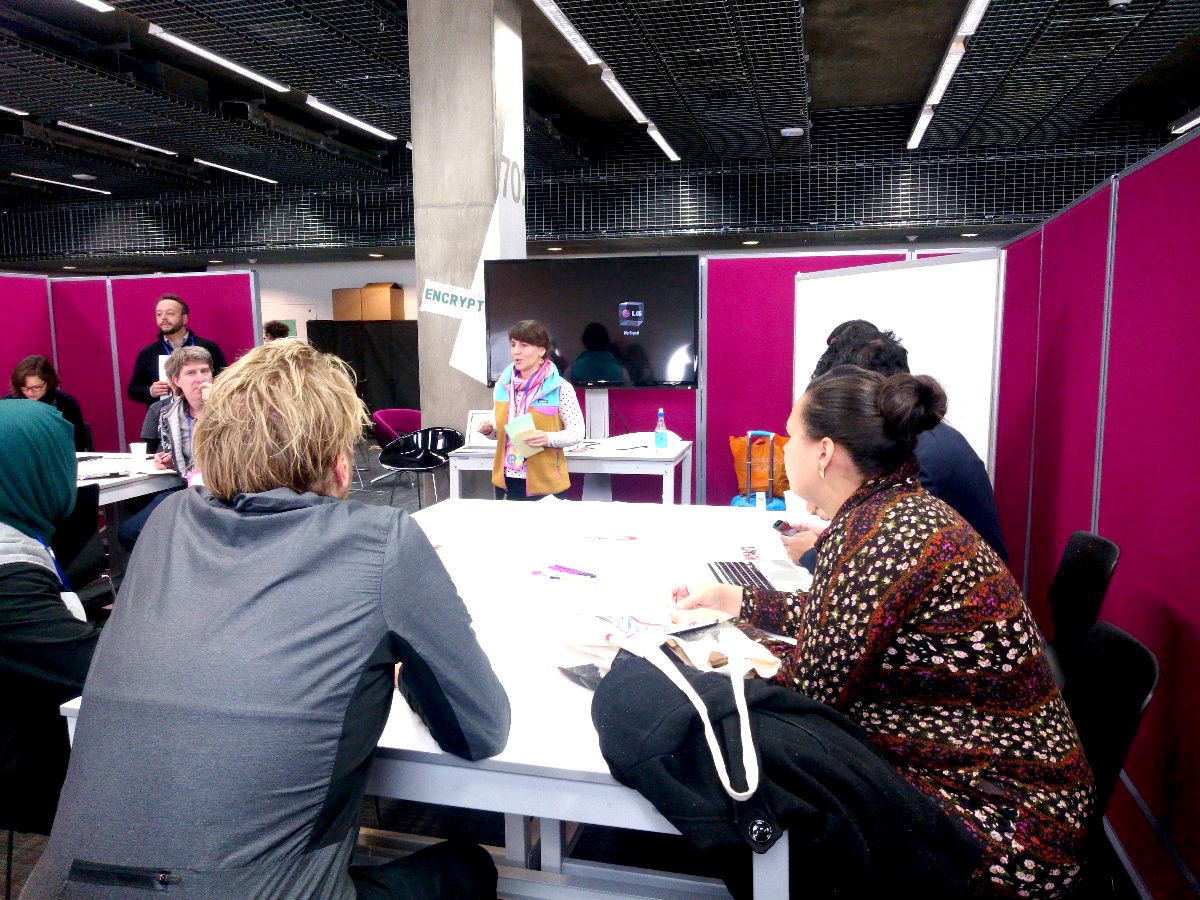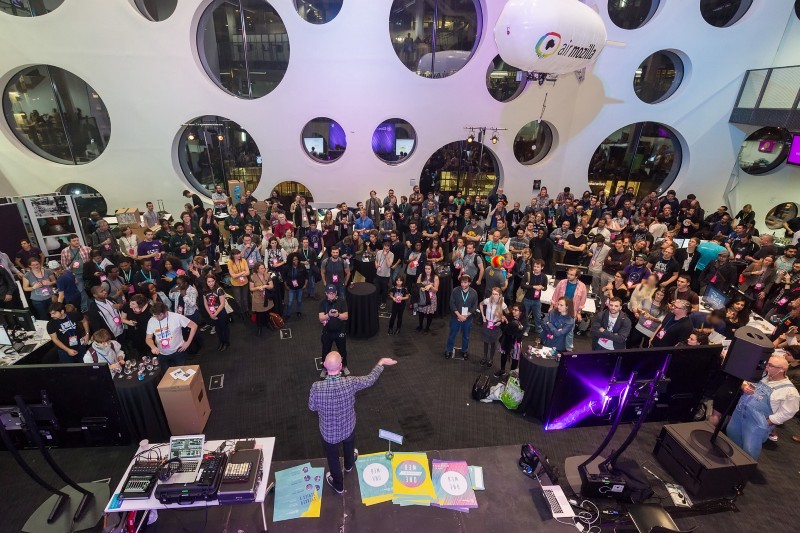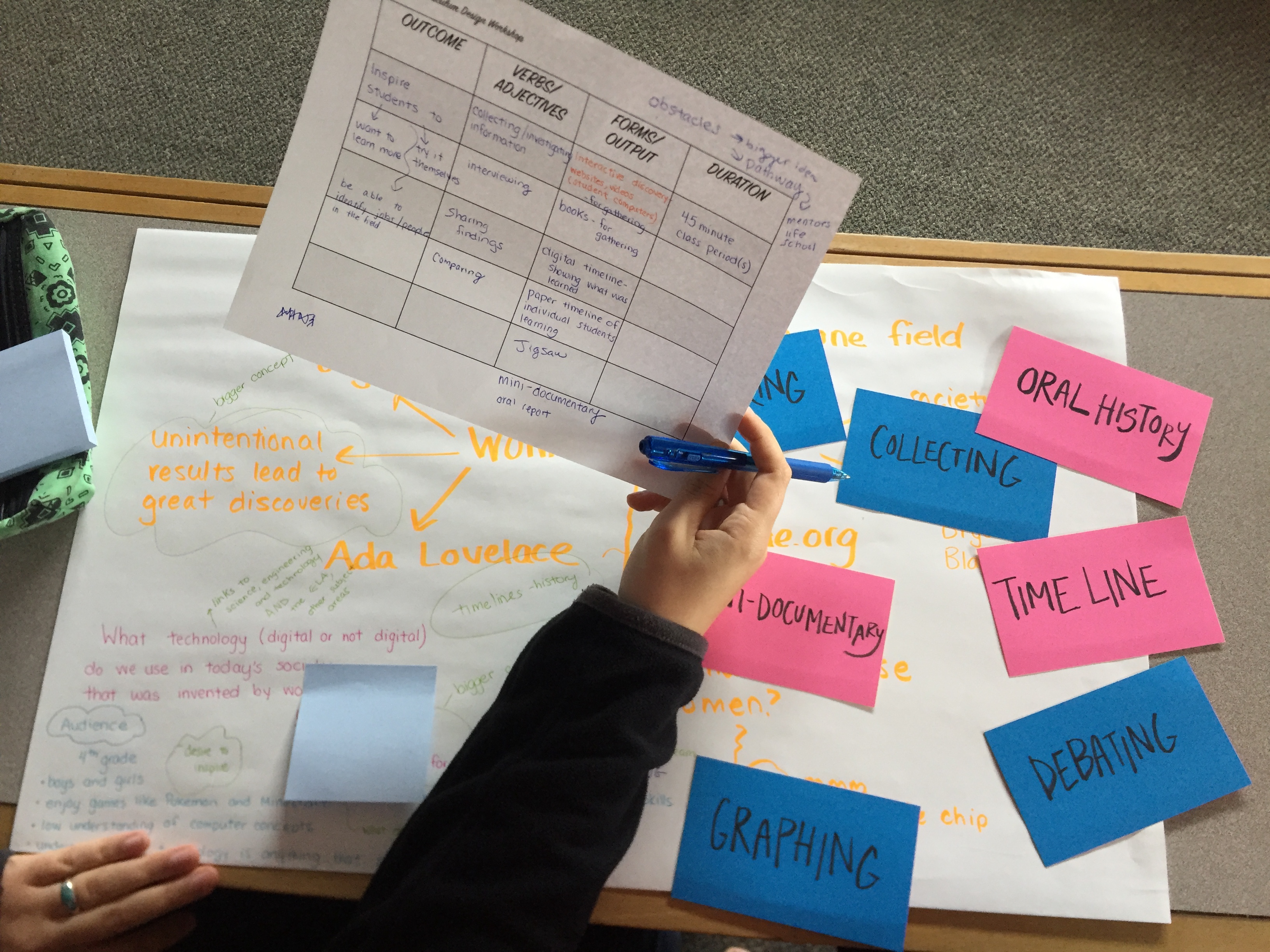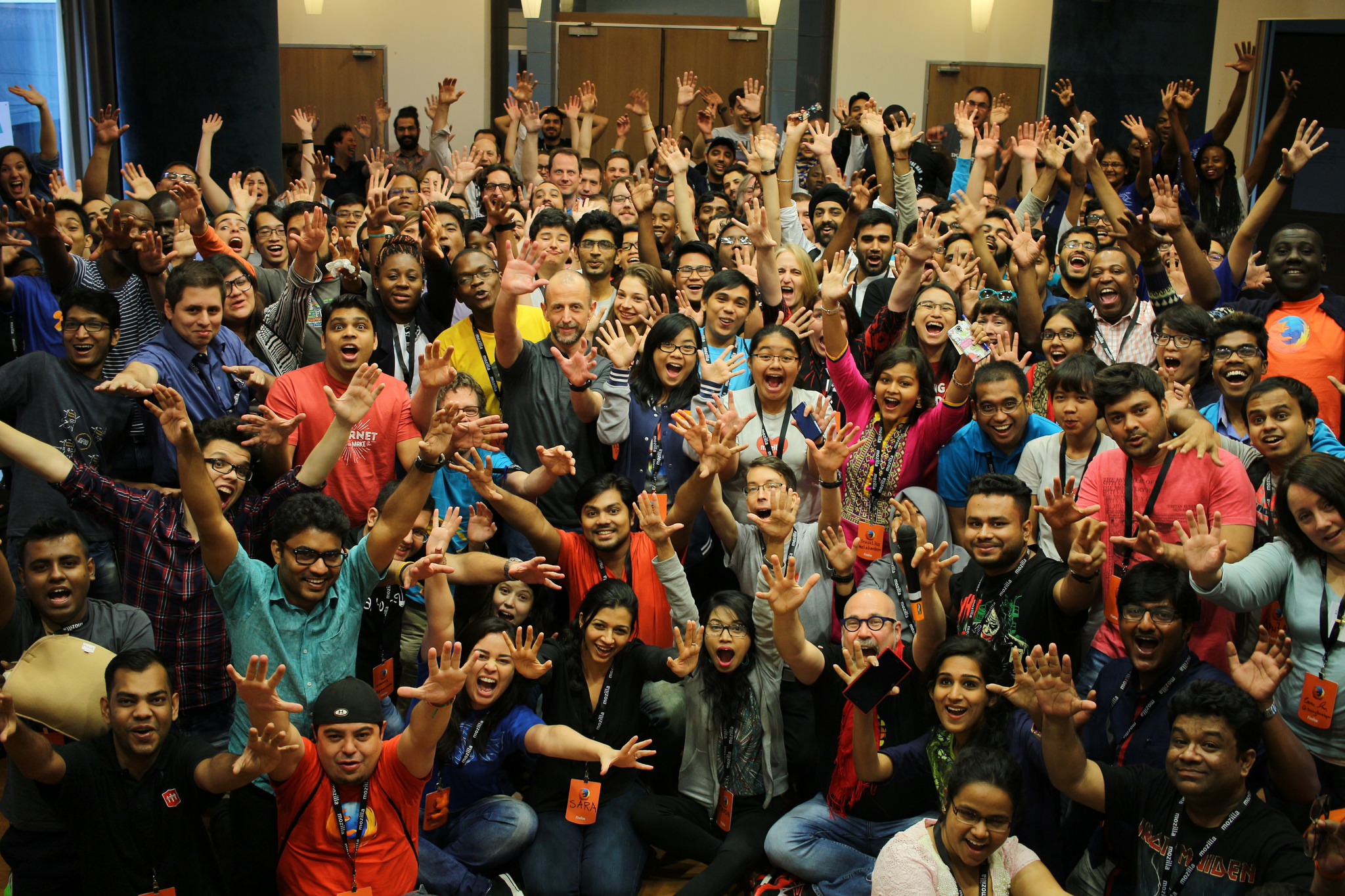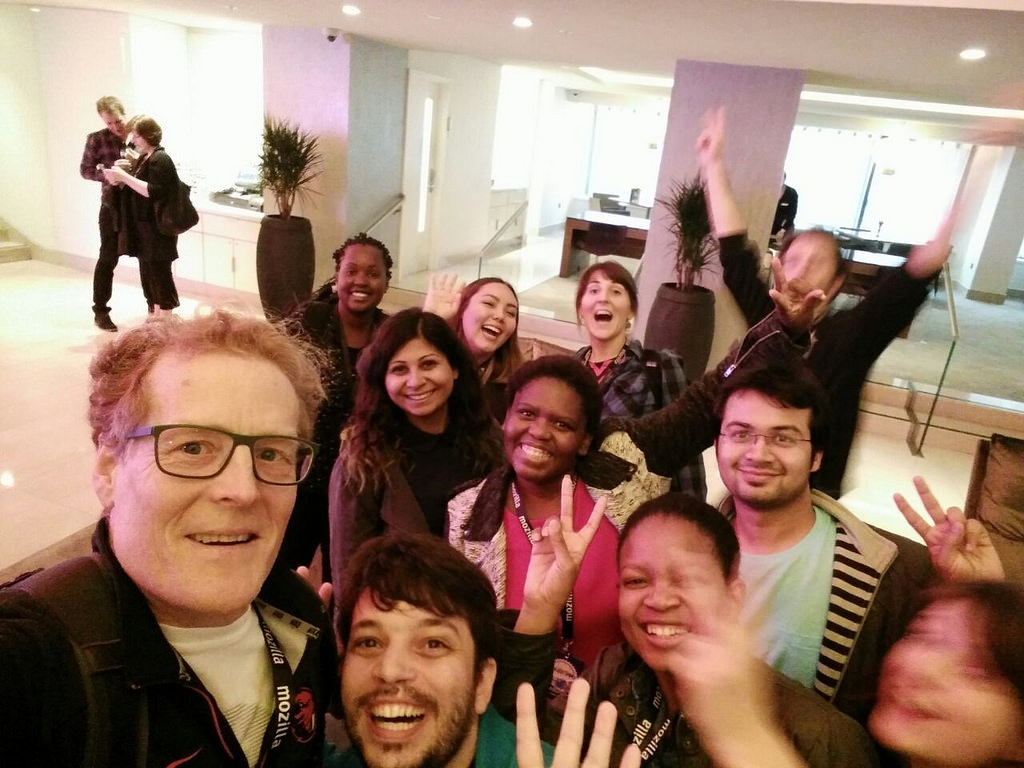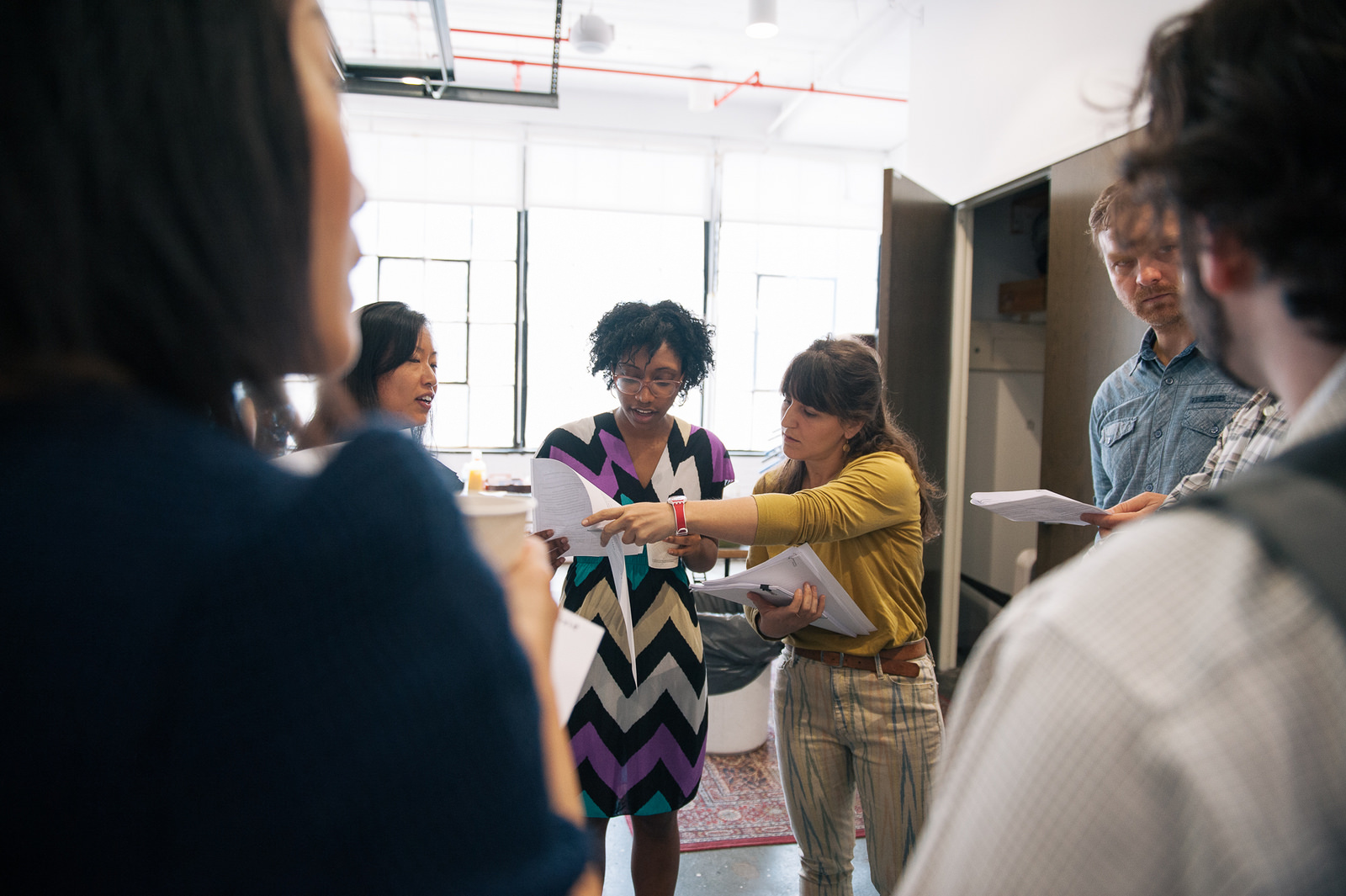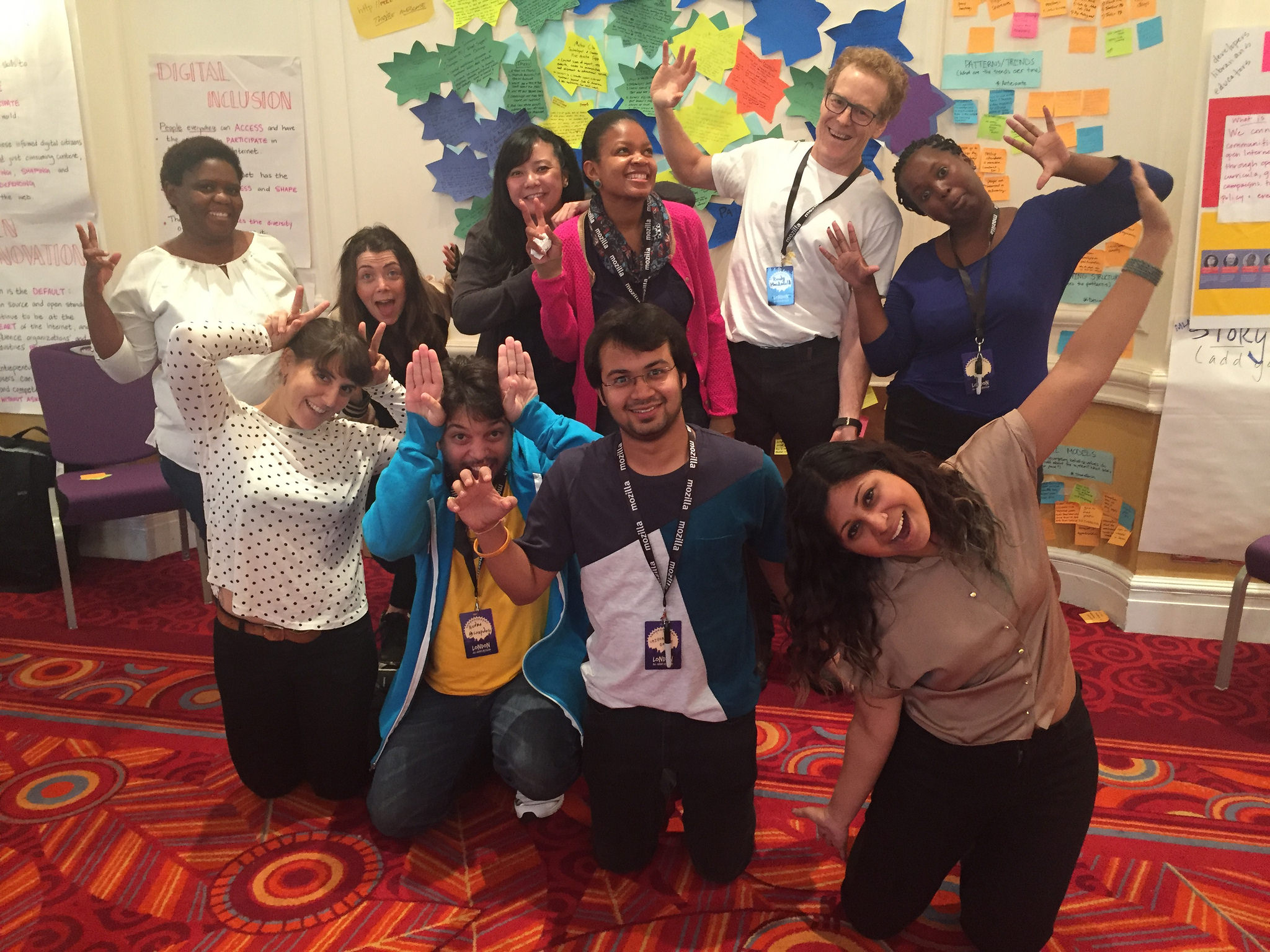Mozilla DOT Clubs kick off in East Africa
I just got back from an inspiring visit to East Africa where I joined several colleagues from Mozilla and Digital Opportunity Trust (DOT) to work on a new project with people from Kenya, Tanzania, Rwanda, Jordan and Canada. Most of the work we did was in Nairobi and Dar Es Salaam with one short visit to Machakos. Below, I tried to capture some key experiences and learnings from the trip.
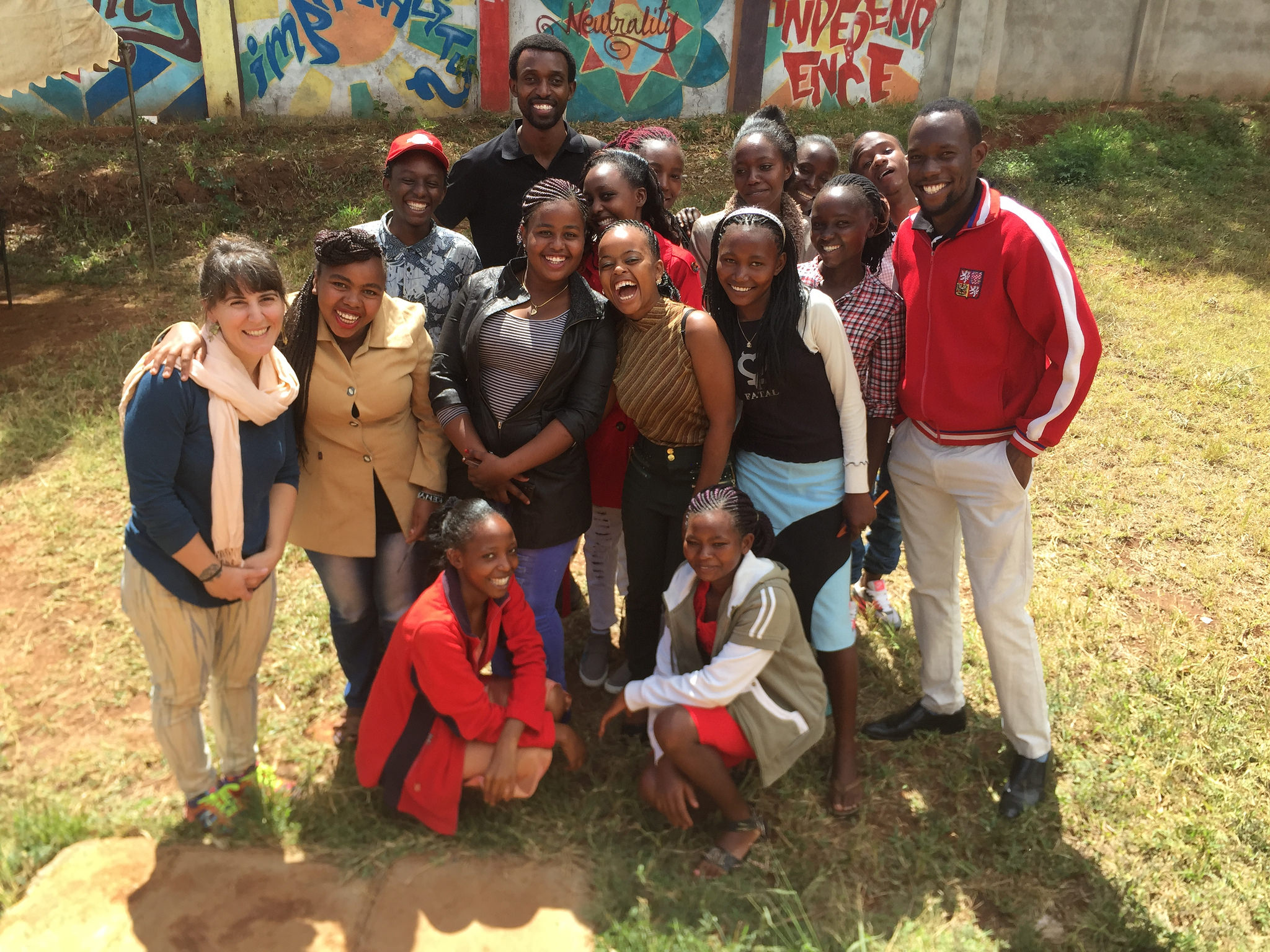
Mozilla DOT Club participants with Club Leader Vincent Juma and Regional Coordinator Dome Dennis in Machakos, Kenya. CC-BY-SA by Mozilla
Project Background
In Collaboration with Digital Opportunity Trust (DOT) we are launching 30+ Mozilla Clubs in Jordan, Lebanon, Kenya, Rwanda and Tanzania over the next six months. Each country has leaders helping to organize and facilitate Clubs in their community. These leaders are experienced facilitators and mentors who were selected by DOT staff to launch the project in each location. For more information here is a description of the benefits of the Mozilla Clubs initiative and why Clubs are an integral component of the DOT Digital Champion program.
Why East Africa?
Kenya, Tanzania and Rwanda are three of the five countries where this project is launching. DOT has dedicated staff and a strong community in each country who we are working closely with to develop the project. Mozilla has a growing community Kenya that is helping to inspire the work for this project. With limited time we were only able to visit Nairobi and Dar Es Salaam, but were fortunate to have Individuals from Jordan and Rwanda join us in Nairobi.
Traveling to Tanzania and Kenya gave us the opportunity to:
- Introduce Open Leadership and Internet Health through an in-person training.
- Develop plans for Mozilla DOT Clubs with local DOT Staff and young leaders.
- Explore content and resources needed to teach web literacy in East Africa.
Three Trainings
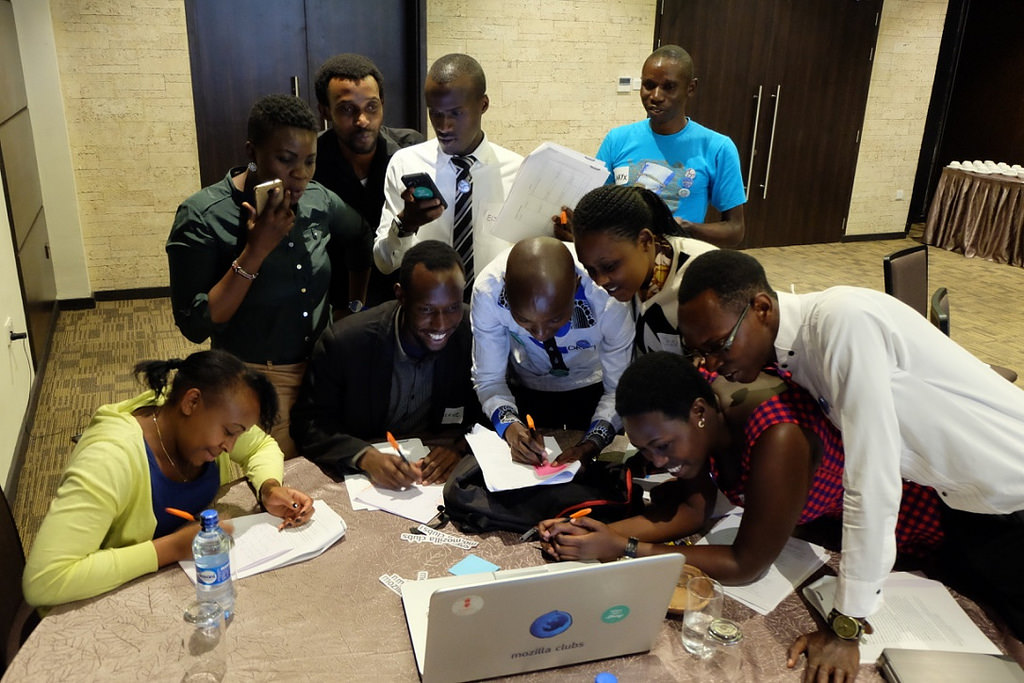
Training attendees check notes while they develop vision statements for their Clubs. CC-BY-SA by Mozilla
Our main focus for this trip was to lead three in-person, day long trainings to introduce Open Leadership practices and principles to DOT Club leaders. Training attendees included 10 DOT Staff and 25 youth leaders. Each training lasted 6–8 hours and covered topics like fostering safe spaces for learning, open source licensing, project based learning, tools for collaboration, digital inclusion, online privacy and much more. Throughout the day participants engaged with each other through deep discussion, group break-outs, physical activities and content creation.
- Training 1: Mozilla Club Leader Training in Dar Es Salaam. An in-person, full day training for individuals facilitating Mozilla DOT Clubs in Tanzania. Participants got an introduction to Mozilla, working open, web literacy, facilitation techniques, tools and resources.
- Training 2: Mozilla Club Leader Training in Nairobi. An in-person, one day training for individuals facilitating Mozilla DOT Clubs in Kenya and Rwanda. Participants got an introduction to Mozilla, working open, web literacy, facilitation techniques, tools and resources.
- Training 3: Mozilla Workshop for DOT Staff. An in-person workshop for DOT staff in Tanzania, Kenya, Rwanda, Jordan and Canada. Participants got an introduction to Mozilla programs, resources and initiatives as they relate to the DOT Digital Champion program.
Through discussion and activities participants gained a better understanding of how to utilize everything Mozilla Clubs has to offer.
Developing The Training
Since December 2016 we’ve been mapping our work for this project. We set the groundwork for this training through several planning calls, a virtual orientation and lots of writing. Working with DOT was a unique opportunity for us to develop a new kind of training for a unique audience that have existing expertise in leadership, community development and education. To complement this expertise we based our training agenda on Open Leadership, Web Literacy and Mozilla Clubs. Here are a few very important goals we had in mind:
- Make it offline: We knew very early on that we wanted to create something that could be done entirely offline. Many of the training participants work in learning environments that have little or no access to internet and/or computers. So, we prepared printed materials and modeled something they could replicate in their local context.
- Incorporate many opportunities for collaboration: This was a unique chance to leverage the in-person quality of this training. We incorporated several group activities that gave attendees a chance to share ideas, experiences and expertise from multiple countries, cities and villages.
- Include several layers of hands-on learning: The content we shared throughout the training demonstrates hands-on learning, including physical games to learn HTML (Hyper Text Markup Language) and have engaging discussions about technology.
- Implement an assessment plan: As a new project this was an opportunity to initiate an ongoing assessment plan starting with the training. We brought a team of assessment experts together from Mozilla and DOT to advise us on developing a registration and training survey. We used these to gather essential feedback before and after the training.

In less than three months we made several iterations of the training agenda and requested feedback from multiple stakeholders. The trainings took place between March 13–21, 2017. CC-BY-SA by Mozilla
Running The Training
This full recap includes the detailed agenda, objectives, survey results and outcomes from the training series. It is openly licensed on Github and can be duplicated as needed.
Attendees explored how to adapt the Mozilla Clubs model in a local framework that encourages safe and open learning spaces online and offline. We discussed complicated topics like teaching in lofi areas, working openly, empowering learners and creating optimal learning environments. Participants shared experiences, learned from each other and connected on many different levels.
We did our best to create a fun, friendly and comfortable environment for everyone. To keep engagement high we moved around a lot and rotated between group brainstorms, activities, team-work and break time. Sometimes the room was filled with laughter and movement. Other times the room was quiet and focused. In each case attendees brought their own personality and ideas to the agenda, which added a wonderful spontaneity to the training that we were pleasantly surprised with.
Additional Experiences & Learnings
While in Nairobi I had a couple more experiences worth noting here. These were not directly related to the trainings described above, but definitely helped to contextualize the learning that happened for me while I was there.
- Digital Skills Observatory (DSO) Convening and Workshop:
In advance of the training in Nairobi I joined 60 other people in a convening to workshop findings from the Digital Skills Observatory. This research project followed 200 first-time smartphone users throughout 2016, and studied the impact of digital skills training on their adoption and usage behaviours. During the convening we discussed findings from the project, and worked in small groups to build new ideas based on them. The workshop was a great introduction to several other organizations and people around the world who are involved in similar areas of technology and education.
2. Site Visit to Mozilla Club Machakos, Kenya:
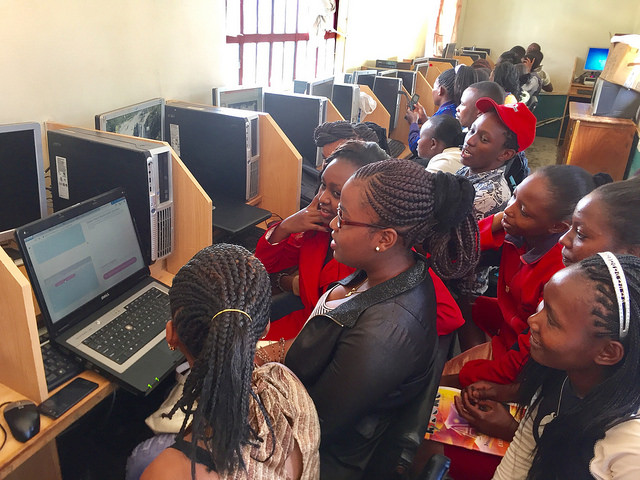
Recent high school graduates learn HTML during a Mozilla DOT Club session in Machakos, Kenya. CC-BY-SA by Mozilla
I was honored to visit a Mozilla DOT Club in action. Mozilla Club Machakos meets every week in a Red Cross facility in the town of Machakos, which is about an hour outside of Nairobi. The Club has 13 Club participants, all of which are recent high school graduates. During my visit, I learned about their hobbies, interests and curiosities. We talked about what they were learning in the Club and how it overlaps with their interests. Some of them were planning to attend university, others were not. In all cases they chose to attend the Club and learn new skills that could help them progress in their personal and professional lives. They share computers during their Club meetings and take turns trying different tools and activities online. While I was there they were learning basic HTML using X-Ray Goggles.
3. Dinner with Digital Inclusion leaders from Kenya:
I had the pleasure of joining seven women for dinner to discuss and learn about the work they are doing related to digital inclusion and gender equality. They are currently working with Mozilla, United Nations and other organizations to increase opportunities for women and girls in technology. A lot of this work is based in Kenya, but extends and inspires multiple other communities around the globe. Amira Dhalla (Lead for Women and Web Literacy at Mozilla) brought us together in a wonderful and friendly exchange filled with inspiration and delicious local food.
What’s Next?
Training participants will now launch Clubs in their home countries. As they recruit Club learners and host Club events they will share their experiences on our community channels. These updates are viewable on the Mozilla Clubs Event Reporter, Mozilla Learning Forum and Clubs Facebook Group.
My learnings from this trip will continue to impact my work for months and years to come. I am inspired by the spirit and culture of the individuals I got to know during my visit. I look forward to working alongside DOT leaders as they grow web literacy and open leadership in their regions.
Special thanks to my co-facilitator Amira Dhalla and DOT Staff Roy Lamond, Christine Kelly, Dome Dennis, Judy Muriuki and Frederick Sigalla for their assistance with organizing the events. For more about this work check out Amira Dhalla’s Training Digital Leaders blogpost and photographs.
Mozilla Clubs at Mozfest 2016
The Mozilla Clubs presence and involvement at Mozfest this year left me feeling proud, motivated and inspired. 16 Club Leaders (Regional Coordinators and Club Captains) from across the world came together for one of Mozilla’s largest networking opportunities of the year. They joined more than 1800 people in a three day extravaganza of interactive sessions, hands-on activities and engaging talks. As a growing network (averaging one new club a day) of individuals from 48+ countries around the globe the diversity of Mozilla Clubs was well represented with Club Leaders from Mexico, India, South Africa, Kenya, Brazil, Italy, Philippines, Switzerland, United Kingdom, Canada and Greece.
On Friday, October 28 Club Leaders were invited to participate in two pre-Mozfest kick off gatherings. The first was a morning training that introduced best practices and tips for facilitating engaging sessions. The second was an afternoon meet-up that brought Club Leaders together to connect in person before going to a science fair where festival visitors explored new projects and networked with peers.
Saturday’s opening ceremony introduced space themes, logistics and what to expect during the festival. A DJ performance and brief talk from the Executive Director of the Mozilla Foundation got everyone energized for an exciting weekend filled with sharing and learning. Over the next two days Club Leaders facilitated sessions, explored projects, organized spaces, curated media channels, connected with new people and much more. Here are few examples of how:
- Regional Coordinator Hilda Nyakwakwa and Club Captain Maryann Wangari held a session on developing solutions that address societal issues affecting women from all over the globe. Their session used storytelling to talk about creating safe spaces for women to practice reading, writing and participating on the web.
- Club Captain Edoardo Viola and Club Captain Faye Tandog co-lead a session that introduced several ways to collaborate on projects through the Open Leadership Training Series (OLTS). These included a guide to fuel open practices in Universities, apps for community empowerment and resources for Mozilla Campus Clubs.
- Regional Coordinator, Su Adams was a key organizer for the Demystify the Web space and had multiple roles throughout the festival, including designing the floor layout, building props, managing logistics and directing visitors. She participated in multiple sessions and facilitated an ongoing drop-in station for interactive gaming, circuit building and hacking.
Club Leaders were encouraged to discover everything Mozfest had to offer. In addition to meeting each other and learning about each other’s work, they networked with peers and gathered knowledge to share back with their communities. Regional Coordinator, Mmaki Jantjies reflected on her experience in a blog post calling Mozfest “a candy store that allowed anyone to put technology and science back into the hands of everyday human beings, allowing them to address everyday issues through technology platforms.”
On Sunday the Mozilla Club session brought people together to focus on Clubs and it’s growing network of global community members. Of the thirty session participants, sixteen were currently involved in Clubs, and the remainder came to learn about our network.
The main goal of the session was to introduce new people to the Clubs model and give Club members an opportunity to develop ideas, plan,network and peer assist. We started by breaking into pairs to learn about each other’s work and interests. Non-Clubbers were paired with current Clubbers so they could hear examples of how Clubs function directly from the people that facilitate them.
After this initial discussion, we came back together for a deeper dive into the Clubs program. Participants broke into two large groups based on their current involvement in Clubs. People new to Clubs formed a group to learn more about what they are and how to start them. People already involved in Clubs formed a group to explore successes, challenges and solutions for their individual Clubs. The conversation continued well beyond the end of the session and resulted in this collection of ideas we will utilize in club planning for 2017:
Following the session Club leaders from South Africa, Mexico and Kenya joined a Mozilla Learning Curriculum Workshop to discuss various ways learning and making was happening at the festival. They drew comparisons between the learning they saw taking place at the festival and the learning they cultivate in their local communities. Everyone brought a different area of expertise to the discussion creating an informative dialogue about how to teach Digital Literacy through Clubs, after school programs, maker spaces, community centers and more.
Mozilla Festival concluded with a celebration and demo fair. Projects that were created and/or presented during the festival were put on display, “Thank you’s” were exchanged and dancing filled the floor. Club Leaders left with a better understanding of each other’s work and how it connects to the larger Mozilla mission.
For the next couple of weeks following Mozfest Club Leaders reflected on their time and how it will impact them moving forward. Their images and words do a great job at capturing the one of a kind experience Mozfest truly is. Some of them are featured below.
I am grateful for the unique perspective and dedication Club Leaders brought to Mozfest this year and I look forward to our continued work together. A huge thanks to everyone who was able to join us and for those who were not, there will be more!
“…this experience was not only an exercise to open the mind and heart to OpenSource, it was an innovative way to make technology in an Open way.” Club Captain, Edoardo Viola
“Eu conheci novas tecnologias na feira de ciência, conheci muitas pessoas e coloquei a mão na massa aprendendo a trabalhar de forma prática com muitos projetos e sessões, além de me apaixonar pelas sessões de artes.” Club Captain, Geraldo Barros
“…decision systems becomes a part of our life and we need to make sure that things are decentralized and power is in the hand of the user.” — Club Captain, Vigneshwer Dhinakaran
“…many root causes and symptoms are common throughout the world, but the solutions to address these issues most often need to be context-specific.” Space Wrangler and Club Captain, Kim Wilkens
“Conocer las similitudes entre México y Kenia, fue un parte aguas para mi, ya que el conocer contextos sociales parecidos me ha otorgado una gran pauta para trabajar en equipo.” Club Captain, Liza Durón.
Ada Lovelace Day Curriculum Design Workshop at Libre Learn Lab
This blog post was co-authored by Zannah Marsh and Julia Vallera
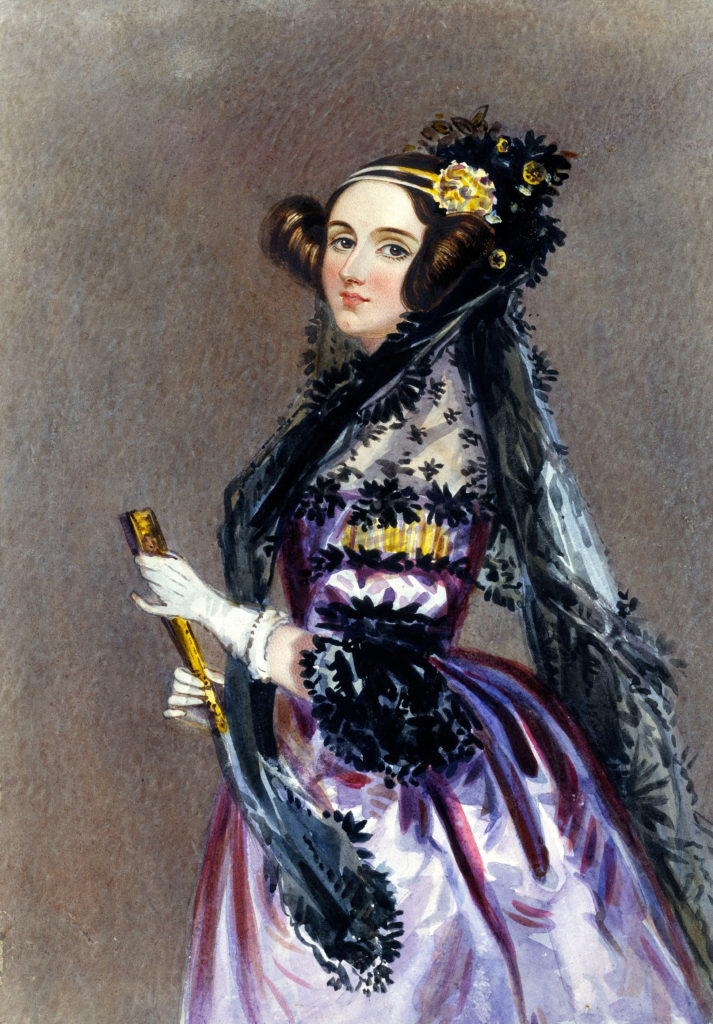 October 11 was Ada Lovelace Day, an annual celebration of the contributions of women to the fields of Science, Technology, Engineering, and Mathematics (also known as STEM). Born in 1815, Lovelace was given a rigorous education by her mathematician mother, and went on to devise a method for programming the Analytical Engine, a conceptual model for the first-ever general purpose computer. Lovelace (pictured here in full Victorian splendor) is known as the first computer programmer. This year, Ada Lovelace Day presented the perfect opportunity for Mozilla to engage community members in something cool and inspiring around the contributions (past and future) of women and girls in STEM. Zannah from the Mozilla Science Lab(MSL) and Julia from the Mozilla Clubs program decided to team up to run a women in STEM themed session at Libre Learn Lab, a two-day summit for people who create, use and implement freely licensed resources for K-12 education. We jumped at this chance to collaborate to make something fun and new that would be useful for both of our programs, and the broader Mozilla community.
October 11 was Ada Lovelace Day, an annual celebration of the contributions of women to the fields of Science, Technology, Engineering, and Mathematics (also known as STEM). Born in 1815, Lovelace was given a rigorous education by her mathematician mother, and went on to devise a method for programming the Analytical Engine, a conceptual model for the first-ever general purpose computer. Lovelace (pictured here in full Victorian splendor) is known as the first computer programmer. This year, Ada Lovelace Day presented the perfect opportunity for Mozilla to engage community members in something cool and inspiring around the contributions (past and future) of women and girls in STEM. Zannah from the Mozilla Science Lab(MSL) and Julia from the Mozilla Clubs program decided to team up to run a women in STEM themed session at Libre Learn Lab, a two-day summit for people who create, use and implement freely licensed resources for K-12 education. We jumped at this chance to collaborate to make something fun and new that would be useful for both of our programs, and the broader Mozilla community.
At MSL and Mozilla Clubs, we’ve been experimenting with creating “train-the-trainer” materials, resources that are packed with all the info needed to run a workshop on a given topic (for example, this resource on Open Data for academic researchers). There are 200+ clubs around the world meeting, making, and learning together… and many are eager for new curriculum and activities. In both programs and across Mozilla, we’re committed to bringing learning around the open web and all the amazing work it enables (from mathematics to advocacy) to as wide an audience as possible, especially to populations that have traditionally been excluded, like women and girls. Mozilla Learning has been running online, hour-long curriculum workshops on a monthly basis, in which users discuss a topic and get to hack on curriculum together, and had planned a special Ada Lovelace Day edition. We resolved to make an Ada Lovelace Day in-person event that would link together our “train-the-trainer” model and online curriculum creation initiatives, and help meet the need for new material for Clubs… all while highlighting the issue of inclusion on the open web.
Developing the workshop
After kicking around a few ideas for our Libre Learn Lab session, we settled on an intensive collaborative curriculum development workshop to guide participants to create their own materials inspired by Ada Lovelace Day and the contributions of women and girls to STEM. We drafted the workshop plan, tested it by working through each step, and then used insights from prototyping to make tweaks. After incorporating suggestions from key stakeholders we arrived at the final product.
What we came up with is a workshop experience that gets participants from zero to a draft by prototyping curriculum in about one and a half hours. In this workshop, we made a particular effort to:
- Encourage good, intentional collaboration by getting participants to brainstorm and agree on guidelines for working together
- Get users to work creatively right away, and encourage them to work on a topic they find fascinating and exciting
- Introduce the idea of design for a specific audience (AKA user-centered design) early on, and keep returning to that audience (their needs, motivations, challenges) throughout the design process
- Create a well-structured process of idea generation, sharing, and refining (along with a matrix to organize content) to get participants past decision making on process that can often hinder creative collaboration
If you’d like to know more you can take a look at the workshop plan, carefully documented on GitHub in a way that should make it easily reusable and remixable by anyone.
Running the workshop
On October 8 put our plans into action at Libre Learn Lab. The conference (only in its second year) had a small turnout of highly qualified participants with valuable experience in the field of education and open practices. Everyone who came to our workshop was connected to curriculum development in some way — teachers, program managers, and directors of educational organizations. After introducing the workshop theme and agenda with a short slide deck we brainstormed new ideas and worked in groups to refine or expand our ideas and prototype new curriculum. At the end of the session, we asked users to fill out a short survey on their experience.
The workshop development and implementation process so far has resulted in new lessons on understanding how climate effects living things and on women inventors throughout history. These are available in the GitHub repository for public use — and keep an eye on this, as we’ll be adding more lessons soon. Every workshop participant was eager to develop their materials further and use them with audiences ASAP. Thanks to Megan Black, Felix Alvarado, Victor Zuniga, and Don Davis for creating curriculum!
Wrap up and learnings
We got useful feedback from participants that will help make future evolutions of this workshop stronger. From our survey results we learned that participants loved the opportunity to collaborate, get hands-on experience and connect with Mozilla. They also liked having the matrix and sample cards as prompts. Suggested improvements included a desire for more curriculum examples, and the need for more time for prototyping. As facilitators, we’ll look for ways to encourage participants to move around the room and mix with other groups. We will look at improving our slides as an activity guide with clearer instructions. We’d like to find better ways for latecomers to jump in and find more ways to engage participants with different learning styles (for example more visual learners). We also learned that with ten or more participants it is best to have three or more facilitators in this type of intensive workshop.
We hope to find a time to run another session of the workshop in the Open Learning Circle in our Demystify the Web Space at this weekend’s Mozfest — keep an eye on the #mozfest hashtag on twitter for an announcement or reach out to us if you’d like to join.
Introducing Mozilla Campus Clubs
In 2015, The Mozilla Foundation launched the Mozilla Clubs program to bring people together locally to teach, protect and build the open web in an engaging and collaborative way. Within a year it grew to include 240+ Clubs in 100+ cities globally, and now is growing to reach new communities around the world.
Today we are excited to share a new focus for Mozilla Clubs taking place on a University or College Campus (Campus Clubs). Mozilla Campus Clubs blend the passion and student focus of the former Firefox Student Ambassador program and Take Back The Web Campaign with the existing structure of Mozilla Clubs to create a unified model for participation on campuses!
Mozilla Campus Clubs take advantage of the unique learning environments of Universities and Colleges to bring groups of students together to teach, build and protect the open web. It builds upon the Mozilla Club framework to provide targeted support to those on campus through its:
- Structure: Campus Clubs include an Executive Team in addition to the Club Captain position, who help develop programs and run activities specific to the 3 impact areas (teach, build, protect).
- Specific Training & Support: Like all Mozilla Clubs, Regional Coordinators and Club Captains receive training and mentorship throughout their clubs journey. However the nature of the training and support for Campus Clubs is specific to helping students navigate the challenges of setting up and running a club in the campus context.
- Activities: Campus Club activities are structured around 3 impact areas (teach, build, protect). Club Captains in a University or College can find suggested activities (some specific to students) on the website here.
These clubs will be connected to the larger Mozilla Club network to share resources, curriculum, mentorship and support with others around the world. In 2017 you’ll see additional unification in terms of a joint application process for all Club leaders and a unified web presence.
This is an exciting time for us to unite our network of passionate contributors and create new opportunities for collaboration, learning, and growth within our Mozillian communities. We also see the potential of this unification to allow for greater impact across Mozilla’s global programs, projects and initiatives.
If you’re currently involved in Mozilla Clubs and/or the FSA program, here are some important things to know:
- The Firefox Student Ambassador Program is now Mozilla Campus Clubs: After many months of hard work and careful planning the Firefox Ambassador Program (FSA) has officially transitioned to Mozilla Clubs as of Monday September 19th, 2016. For full details about the Firefox Student Ambassador transition check out this guide here.
- Firefox Club Captains will now be Mozilla Club Captains: Firefox Club Captains who already have a club, a structure, and a community set up on a university/college should register your club here to be partnered with a Regional Coordinator and have access to new resources and opportunities, more details are here.
- Current Mozilla Clubs will stay the same: Any Mozilla Club that already exists will stay the same. If they happen to be on a university or college campus Clubs may choose to register as a Campus Club, but are not required to do so.
- There is a new application for Regional Coordinators (RC’s): Anyone interested in taking on more responsibility within the Clubs program can apply here. Regional Coordinators mentor Club Captains that are geographically close to them. Regional Coordinators support all Club Captains in their region whether they are on campus or elsewhere.
- University or College students who want to start a Club at their University and College may apply here. Students who primarily want to lead a club on a campus for/with other university/college students will apply to start a Campus Club.
- People who want to start a club for any type of learner apply here. Anyone who wants to start a club that is open to all kinds of learners (not limited to specifically University students) may apply on the Mozilla Club website.
Individuals who are leading Mozilla Clubs commit to running regular (at least monthly) gatherings, participate in community calls, and contribute resources and learning materials to the community. They are part of a network of leaders and doers who support and challenge each other. By increasing knowledge and skills in local communities Club leaders ensure that the internet is a global public resource, open and accessible to all.
This is the beginning of a long term collaboration for the Mozilla Clubs Program. We are excited to continue to build momentum for Mozilla’s mission through new structures and supports that will help engage more people with a passion for the open web.
Share your expertise with Mozilla Clubs around the world!
Club guides are an important part to the Mozilla Clubs program as they provide direction and assistance for specific challenges that clubs may face during day-to-day operation. We are looking for volunteers to help us author new guides and resources that will be shared globally. By learning more about the process and structure of our guides, we hope that you’ll collaborate on a Mozilla club guide soon!
Background
In early 2015, Mozilla Clubs staff began publishing a series of guides that provide Club leaders with helpful tips and resources they need to maintain their Clubs. Soon after, community members began assisting with, collaborating on and authoring these guides alongside staff.
Guides are created in response to inquiries from Club Captains and Regional Coordinators around challenges they face within their clubs. Some challenges are common across Clubs and others are specific to one Club. In either case, the Mozilla Clubs team tries to create guides that assist in overcoming those challenges. Once a guide is published, it is listed as a resource on the Mozilla Clubs’ website.
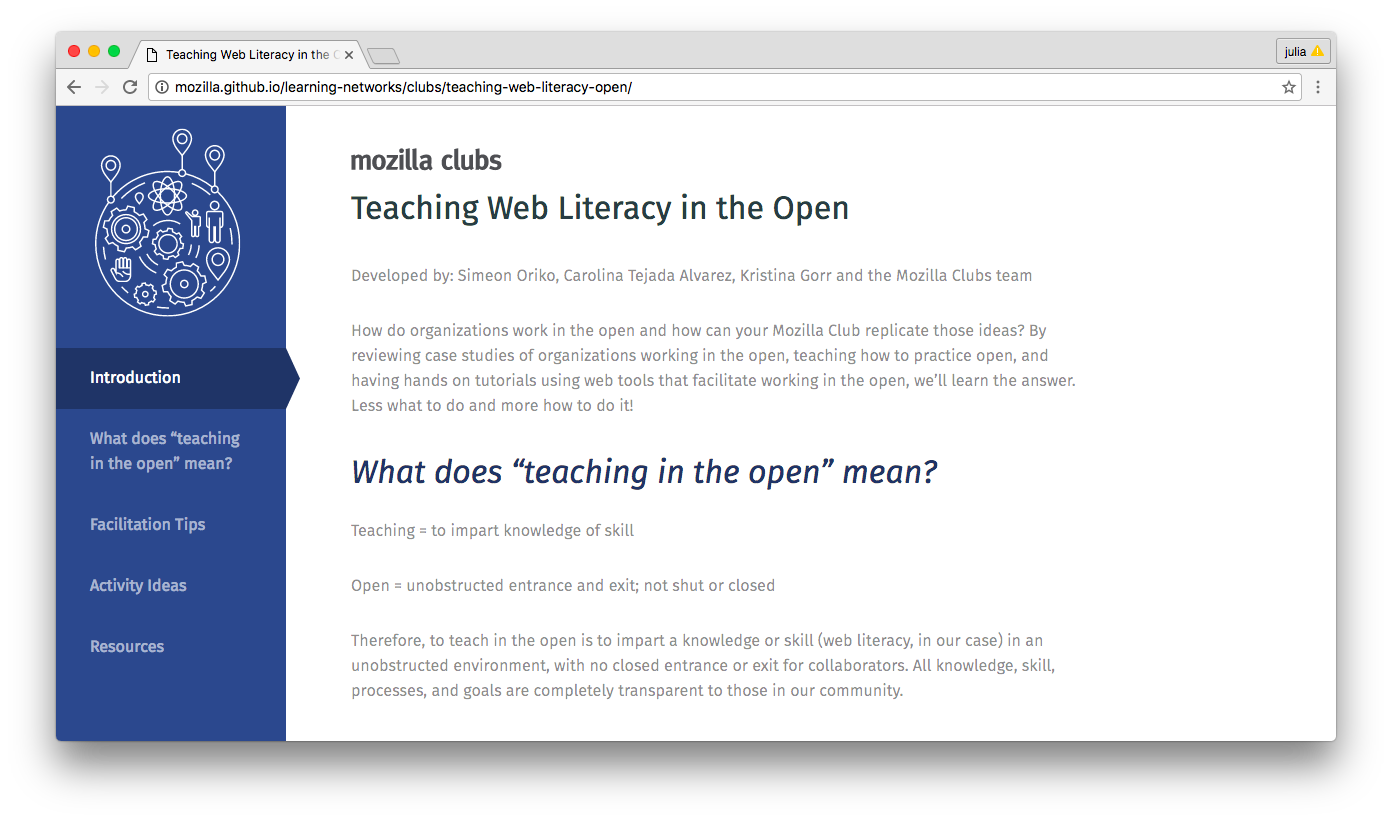
Screenshot of a guide co-authored by Simeon Oriko, Carolina Tejada Alvarez, Kristina Gorr and the Mozilla Clubs team
How are club guides used around the world?
At Mozilla Clubs, there is a growing list of guides and resources that help Club participants maintain Club activity around the world. These guides are in multiple languages and cover topics related to teaching the web, sustaining communities, growing partnerships, fostering collaborations and more.
Guides should be used and adapted as needed. Club leaders are free to choose which guides they use and don’t use. The information included in each guide is drawn from experienced community leaders that are willing to share their expertise. Guides will continue to evolve and we welcome suggestions for how to improve them. The source code, template and content are free and available on Github.
Here are a few examples of how guides have been used:
- A new Club Captain is wondering how to teach their Club learners about open practices so they read the “Teaching Web Literacy in the Open” guide for facilitation tips and activity ideas.
- A librarian is interested in starting a Club in a library and uses the “Hosting a Mozilla Club in your Library” guide for tips and event ideas.
- A Club wants to a make a website, so they use the “Creating a website” guide to learn how to secure a domain, choose a web host and use a free website builder.
What is the process for creating club guides?
The process for creating guides is evolving and sometimes varies on a case-by-case basis. In general, it goes something like this:
Step 1: Club leaders make suggestions for new guides on our discussion forum.
Step 2: Mozilla Club staff respond to the suggestion and share any existing resources.
Step 3: If there are no existing resources, the suggestion is added to a list of upcoming guides.
Step 4: Staff seek experts from the community to contribute or help author the guide (in some cases this could be the person who made the suggestion).
Step 5: Once we find an expert (internal to Mozilla or a volunteer from the community) who is interested in collaborating, the guide is drafted in as little or as much time as needed.
We currently have 50+ guides and resources available and look forward to seeing that number grow. If you have ideas for guides and/or would like to contribute to them, please let us know here.
Mozilla Clubs end of year goals
Mozilla Clubs are excited to share our goals for the rest of 2016. We’ve come a long way since the program’s launch in 2015. What lies ahead for us is exciting and challenging. Below is what we will be working on and information about how you can join in the fun.
Curious to learn more about Mozilla Clubs? Check out our website, facebook page, event gallery, and discussion forum.
Our process
In June 2016, eight Mozilla Club leaders came together in London, UK for Mozilla’s bi-annual All Hands gathering. They participated in many conversations, one of which was a 90 minute deep dive session to identify objectives for clubs over the next six months. During the session we brainstormed topics, ideated in pairs and had a group share out. In addition to informing our goals for the rest of 2016, this session gave club leaders the opportunity to learn more about each other’s work and regional challenges.
In July, we shared the results of our deep dive session more broadly during our monthly call for club leaders and internal clubs info session. This allowed us to gather more feedback and ultimately votes on what goals we should focus on for Mozilla Clubs between now and January 2017.
Here is the list of goals that resulted, why they are important to our work how we plan to approach them.
Six Month Goals
Curate and/or create new resources for running clubs offline
- Why: We want to build and curate more web literacy curriculum that can be used without internet access so that club participants can learn offline.
- How: We will make our current offline activities and curriculum easier to locate, curate new resources and build new ones.
Connect the community through a global gathering
- Why: Club participants learn from each other and feel connected to a global community when they have the opportunity to see each other face-to-face.
- How: We will draw from event models across Mozilla like global sprints, state of the Hive and Mozilla Festival to connect club participants (virtually and/or in person) to work on challenges, share experiences and exchange knowledge.
Continue to localize content and resources
- Why: As we translate more curriculum, activities and club guides into languages other than English more people can access and learn from them.
- How: We will work with Mozilla volunteers, staff and partners to build localization into the process of content creation and start with translating current activities and creating new location-specific resources.
Reward and recognize club leaders
- Why: Club leaders need rewards and recognition for their work so that they feel empowered to grow and spread web literacy in their communities.
- How: We will recognize club leaders for their work through a formal rewards process and develop an agreement policy to create more clarity around the responsibilities of being a club leader.
Strengthen clubs as an organizing model for Mozilla campaigns
- Why: Mozilla Club participants should continue to have an active role in Mozilla campaigns like Maker Party, Copyright, Take back the Web, Encryption, etc.
- How: We will leverage club calls, office hours, the discussion forum, etc. to get input from club participants as campaigns take shape and will share campaign related activities that can be incorporated into their offerings.
Connect club participants across Mozilla
- Why: Mozilla program participants have a lot of expertise to share and they should be able to connect with each other easily and frequently.
- How: Create opportunities for community members in Clubs, Hives, Open Science and Advocacy to share work with each other, get feedback, build networks and more.
Assess club activity
- Why: It is important that we maintain an accurate and up-to-date list of active clubs so that we can provide support where it is needed most.
- How: We will identify which clubs are active by holding individual meetings, checking in via email and reviewing the club event reporter.
Join in the fun!
Here are some ways you can contribute to our work over the next six months and beyond.
- Connect with a Mozilla Club in your area. Don’t see any clubs in your area? Apply to start your own!
- Help us translate one of our web literacy activities into your preferred language.
- Use our offline activities, tell us what you think and suggest new ones.
- Join our facebook group to get updates about upcoming events and campaigns.
My Parting Thoughts, Updates and Thank Yous to Hive NYC
This post was written by Julia Vallera and is cross-posted from HiveNYC.org
Dear Hive NYC,
As I step away from my role as Hive NYC Network Manager, I leave you with some reflections, parting thoughts, updates and thank yous. My time with this network has made a huge impact on my life and I will forever be grateful for all of the positive experiences it’s given me.
My Hive NYC Story
In October 2011, I started part-time contract work with Hive NYC. I had just finished a Masters degree in Design and Technology and was teaching as an adjunct professor while pursuing an art practice that I still dabble in today. An organization called Girls Write Now (GWN) introduced me to Hive NYC during a project I helped them launch called Digital Remix Portfolio, which has since grown into their current Digital Media program.
GWN was one of several Hive NYC member organizations who received funding that year to develop innovative, connected educational projects for youth. The collaborative and experimental nature of these projects inspired me. Eventually, I met Chris Lawrence, who at the time was the Director of Hive NYC. He introduced me to other organizations and invited me to work on projects with Hive NYC member organizations such as The After School Corporation, Partnership for After School Education, Radio Rookies,Parsons, DreamYard and Girls Write Now. During this time, I had the pleasure of collaborating on:
- Words on Walls – Youth-produced performance of music, spoken word and projections.
- Digital Remix Portfolio – Mastering the craft of writing through digital media creation.
- TASCasaurus – STEM-focused webpages about biodiversity in local neighborhoods.
- Brooklyn Explorers – Youth document their neighborhoods with digital tools and media.
- Summer Quest – A free summer camp for elementary and middle school students.
In October 2013, I joined Hive NYC full time as Network Manager. I worked closely with Chris Lawrence, Lainie DeCoursy and Leah Gilliam to strengthen and grow Hive NYC’s ecosystem. My job was to support community members and create spaces for them to collaborate. I facilitated monthly meet-ups and community calls, led workshops, represented Hive NYC at various conferences, held weekly office hours, ran sessions at Mozilla Festival and so much more. Some highlights of this work are captured here:
- Hive NYC 2015 Year-end review
- Annual State of the Hive gathering
- Hive presence at Emoti-Con!
- Free Web Literacy Training
- Community driven Meet-ups
- Ongoing Learning Lab feedback sessions
- Recognizing Leaders in our community
What’s Next
In June 2016, I transitioned into a new role within the Mozilla Foundation. I am now managing a project called Mozilla Clubs where I am helping a global network of community members share Mozilla’s mission to ensure the Internet is a global public resource, open and accessible to all. In this role, I will help club participants use hands-on, interest-based learning to grow digital literacy in community spaces such as schools, libraries, coffee shops, internet cafes and universities around the world.
Last week, the Mozilla Clubs team spent a week together planning our goals for 2016. We outlined several objectives aiming to advance Mozilla’s ambitious plan to help people everywhere feel empowered, safe and independent as they experience the next wave of openness and opportunity online. Here are some goals Club leaders want to focus on in the next 6 months:
- Teach where the internet is not available
- Organize an international Mozilla club gathering
- Support club leaders and empower them to be successful agents of change.
- Localize curriculum and resources
I see a lot of similarity between my work with Hive NYC and Clubs. Both are community-driven networks that share a passion for education, inclusivity, collaboration, openness and innovation. The main difference is in size and scale. Clubs are smaller, ranging between 3 and 30 people. Each has a different culture and focus. Some Clubs choose to focus on things like developing safe spaces for learning, others choose to focus on hard skills like video editing and programming and everything in between.
I am very excited to share what I have learned from Hive NYC with Club communities around the world and look forward to potential collaborations between Clubs and Hives. I am so grateful for my time with Hive NYC and believe this transition will allow me to contribute in new and even better ways.
Thank You
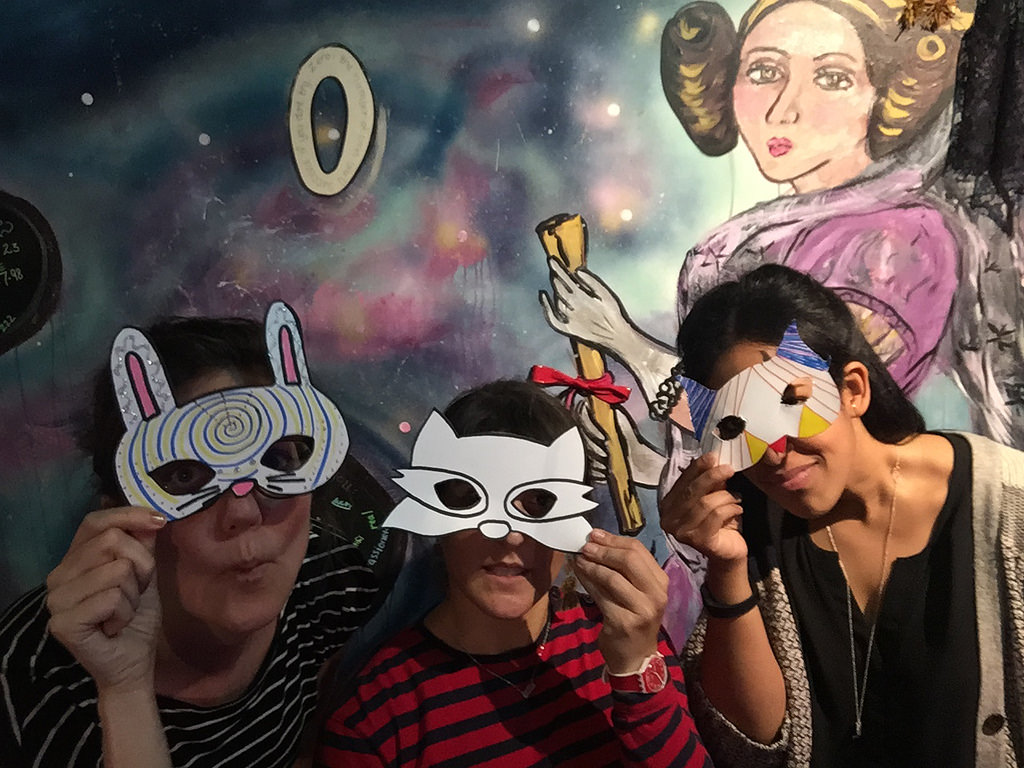
Hillary Kolos, Julia Vallera and Ariam Mogos at the annual Hive NYC holiday party – photo by Hive NYC
To all Hive NYC members, thank you all for your patience, flexibility, availability, honesty, kindness, thoughtfulness and willingness to jump right in. I am constantly amazed at your brilliance and passion for the work that you do. As I tackle new challenges with Mozilla Clubs, I will forever keep you in my thoughts and ask myself “what would Hive NYC do?”
Thank you Chris Lawrence, for your guidance and leadership with Hive and beyond. Dr. Dixie Ching, for your continuous input and for constantly bringing a layer of sincerity and context to our work. Rafi Santo, for your deep investigation and reflections on our work. Marc Lesser, for rallying Emoti-Con! and for bringing a layer of FUN to everything! Ariam Mogos, for Young Innovator Squad and always putting youth voices in the forefront of what we do. Hillary Kolos, for providing constructive feedback to every topic we throw at you! Armando Somoza, for your work on the “Digital Divide” and service to students from under-represented communities. Yvonne Braithwaite, for driving the work on PASE Explorers and the Spread and Scale workshops! Erika Kermani, for Playable Fashion and always being ready to innovate and collaborate. Zac Rudge, for bringing CRC’s into the mix and jumping in at Mozfest 2015! Naomi Solomon, Leah Gilliam, Steve Ausbury, Merle McGee, Delia Kim, Meredith Summs, Brian Cohen, Lori Benson, Tali Horowitz, Sanda Balaban, Courtney Stein, Virgilio Bravo, Steven Goss, Jess Walker, Devin Dillon, Kevin Miklasz, Tina Shoulders, Aaron Lazansky, Tahir Hemphill, Jerelyn Rodriguez, Chris Amos, Lainie DeCoursy and so many more! Thank you!
State of Hive NYC 2015 Recap
On April 23, 2015, 80 Hive NYC members gathered at the American Museum of Natural History for State of Hive NYC. Below is a recap of the event, which highlights these ten features that are truly unique to this community: 1. Generous hosts, 2. Diverse organizations and individuals, 3. Value and opportunity, 4. Community input, 5. Alumni expertise, 6. Vision and purpose, 7. Unique assets, 8. Dance jams, 9. Collaborative vision, 10. Open mic
Every year Hive NYC HQ invites representatives from lead organizations to an annual State of Hive NYC meet-up to participate in a lively discussion about values, purpose and practice. This meet-up is designed to provide an overview of the current Hive NYC landscape and identify goals for collective impact. It is an opportunity to plant the seeds for what comes next and to practice identifying and building upon the larger concerns and commonalities within our work. As network membership and ecosystem grow, our ability to leverage community assets is also strengthened, allowing us to create more robust collaborations.
1. Generous hosts

AMNH swag giveaway at State of Hive NYC 2015
The American Museum of Natural History (AMNH) generously hosted this year’s State of Hive NYC event. They provided wonderful facilities, food and staff to assist us throughout the three hour event. To top it off they surprised us with a very special swag give-away!
AMNH has been a member of the Hive NYC Learning Network since 2009, when Hive NYC was a very new and experimental idea. As a founding member, they have seen the network evolve and grow into what a recent Forbes article calls “one of the more advanced initiatives working to provide tech education to New York City students”. We are grateful to AMNH not only for offering their facilities and time to this event, but also for their amazing contributions to Hive NYC over the last six years. Their continued involvement in the community is a compelling demonstration of what we can achieve as a learning network.
2. Diverse organizations and individuals

Strength and Power in our Differences slide created for State of Hive NYC 2015
More than 70 individuals participated this year, representing a diverse range of youth-serving organizations in NYC. Some are small and new to the network, like Divas For Social Justice. Others are large and have been participating in Hive NYC activity for years, like Parsons The New School for Design. These differing experiences, backgrounds and sources of expertise help make events like this exciting and unique.
Early in the event Leah Gilliam, Director of Hive NYC, talked about “honoring the strength and power in our differences”. Participants were asked to use the event as an opportunity to meet new people and identify where organizational differences and strengths overlap. This set the stage for the activities, discussions and thinking that followed.
3. Value and opportunity

Hive NYC community values and opportunities brainstorm from State of Hive NYC 2015
We started the event with an activity to get participants brainstorming on opportunities and values that members have access to through the network. They wrote ideas down on post-it notes and placed them on one of two prompts hanging on the wall. It was illuminating to see the wall fill up with a variety of responses. Here are a few samples of the results:
- Two of the things I value most about Hive NYC are:
- innovation and talent
- partnership and opportunities
- network and like minds
- Hive gives me the opportunity to:
- see what other organizations are doing and learn how I can support their work
- try new things
- broaden my perspective
4. Community input
We hired a photographer to help us document and capture community reflections and feedback. Along with these photos, we offered a video testimonial booth, where participants could leave short clips about their experiences as Hive NYC community members. 16 participants recorded a range of great ideas and perspectives, touching on topics such as networked thinking, partnerships, digital literacy and youth pathways.
5. Alumni expertise
We invited three Hive NYC Alumni to make guest appearances at the event. All three of them talked about how being a part of the network has guided their work and connected them to new opportunities.
Juan Rubio, formerly the Associate Director of Online Leadership Program at Global Kids Inc., referenced specific projects that demonstrate the opportunity Hive NYC creates for “groups of people coming together and creating really strong programs”. Kevin Miklasz, formerly the Director of Digital Learning at Iridescent, talked about another Hive NYC project highlighting “the ease and the ability in which we are able to form collaborations” and “the openness and flexibility to innovate”. Anne Greg, the Director of Community Programs at Carnegie Hall, described Hive NYC’s impact on youth and how it is “clear that the Hive Learning Network is an engaged and engaging group of leaders who care about young people and care about learning with and from each other”. “If the group can leverage this energy and potential, great things can happen.”
6. Vision and purpose

Leah Gilliam, Director of Hive NYC speaking to participants at State of Hive NYC 2015
After a 10 minute refreshment break, Leah Gilliam energized participants with the opening State of Hive NYC presentation. She began by noting the growing nature of Hive NYC, recognizing the new faces and organizations in the room as proof of Hive NYC’s vibrancy and success. Noting that Hive NYC’s growth was happening in the midst of larger changes, Leah reminded community members of the importance of knowing one’s vision and purpose in the midst of change. Leah specifically pointed to Hive NYC’s importance as a complex and diverse environment, noting that our strength as a network lies in our abilities to learn from and build upon one another’s differences. “Today”, she said “is about vision. It’s about generating a collective and shared vision of what we as a group value in the midst of change.”
Hive NYC is a growing and evolving community. And with growth often comes change. As new organizations and individuals join the network, new priorities and possibilities arise. This affects key features of the landscape. While things like funder priorities, collaboration opportunities and network practices may shift, we don’t want to lose site of our roots, what balances us and what is important to us—the hive community.
Leah concluded with an introduction to the next activity designed to help organizations think about what they valued as well as a sense of the collective value of Hive NYC.
7. Unique assets

Following Juan Rubio’s thoughtful video and Leah Gilliam’s bird’s-eye view of Hive NYC, participants got started on an activity to identify and map organizational assets to a modified Success Weakness Opportunities Threats (SWOT) Hand-out. A SWOT analysis (alternatively called SWOT matrix) is a “structured planning method used to evaluate the strengths, weaknesses, opportunities and threats involved in a project”. “It can be carried out for a product, place, industry or person and involves specifying the objective of the project and identifying the internal and external factors that are favorable and unfavorable to achieve that objective.” (Wikipedia)
What resulted was a large collection of assets ranging from expertise, to on-site equipment, curricular resources and much more. Documenting these assets was the first step in identifying innovations, non-negotiables and important components to each member’s work with Hive NYC going forward.
After completing the hand-out individually, participants were asked to find a partner (someone they had never worked with before) and discuss their responses. They exchanged their SWOT Matrix and learned about the similarities and differences in what was shared.
8. Dance jams
In-between activities and discussions, we enjoyed some classic hip-hop jams thanks to a playlist by Melissa Anderson. Tracks include Let the Music Play by Shannon, I’m Gonna Get You by Bizarre Inc., Everybody, Everybody by Black Box, Back to Life by Soul II Soul and more.
9. Collaborative vision

Vision statement created by community members at State of Hive NYC 2015
The last activity of the day was a group exercise, with ten groups of roughly seven people. Over the course of around 40 minutes, each group created a collaborative Hive NYC vision statement. Getting there was not easy.
Groups started by choosing four assets from their SWOT analysis and listing them on post-it notes. They discussed and curated their lists to determine where and how each of their organizations aligned. Through this conversation and as they mapped out their vision for Hive NYC, groups were asked to consider the overarching Mozilla Hive Learning goals to Mobilize, Create, Catalyze and Grow. Groups were given a sample sentence to work from, but encouraged to create one of their own. These guiding questions helped as they collaboratively worked:
- How can what you value in Hive NYC (refer to first activity) and your organizational assets (see SWOT Matrix) ground this vision statement?
- What can you agree on with your group members?
- What do you want to see going forward based on current Hive NYC realities and opportunities?
Each statement was hung on the wall and one person from each group presented the idea by reading it aloud. Each participant was then able to choose the statement they agreed with most. They could vote on the full statement or choose a small piece by placing a dot sticker near it.
10. Open mic

Naomi Solomon from MOUSE announces an upcoming event at State of Hive NYC 2015
We closed the event with an open mic. Several participants stood up to announce upcoming events, opportunities, reflections and youth programs. Naomi Solomon, from MOUSE, shared details and exciting updates about Emoti-con!. Hillary Kolos, from Dreamyard, gave an update about an ongoing collaboration with Parsons the New School for Design: Digital Learning Portfolios. Aaron Lazansky (a.k.a SpazeCraft), an independant artist teaching for several organizations, announced his work on an upcoming youth produced radio show.
This type of closing is very common among Hive NYC community gatherings. It is a representation of the constant activity and unwavering commitment individuals in this network share.
The State of Hive NYC meet-up reflects the unique set of characteristics that make this community such a valuable one to be part of. Our creativity, diversity of expertise and resources, and connections to one another through the network together make our ambitious goals achievable.
Hive NYC Programs Update: Spring 2015
This is a community update from Julia Vallera, Programs Manager at Hive NYC Headquarters (Hive HQ).
A lot of great things are happening at Hive NYC! With 278 individual members and 82 organizations, Hive NYC is bigger than ever. As part of a global learning network, showcasing our amazing NYC community is hugely important. The time and effort we all put in makes this a strong and supportive network, so let’s take a moment to recognize it!
Below is a summarized selection of Hive NYC activity between January 2015 and April 2015. Each example is mapped to one of four categories of central importance to Hive Learning Networks’ vision and goals.
We welcome the community to submit ideas to Hive NYC’s events calendar. Many of these submissions have helped generate the examples listed below.

Leah Gilliam (Hive NYC) and Ela Ben-Ur (i2i Experience) explore ideas at a recent Hive NYC office hours visit.
Mobilize
Hive NYC mobilizes current and prospective members to adopt connected learning practices and teach web literacy. Our ongoing series of community events covers a wide range of topics and helps to cultivate collaborations, strengthen partnerships and increase capacity to innovate.
- Hive NYC Office Hours: We’ve enjoyed meeting many new individuals and organizations during our weekly Hive NYC office hours. These meetings lead to opportunities and generate exciting ideas that benefit the whole network. Divas for Social Justice introduced us to their new STEAM camp in Bedford Stuyvesant, Brooklyn. Brain Pop showed us their collection of Educational materials for teachers. We met with author Steve Preskill to discuss his work on pathways to leadership and best practices for democratic learning environments. Additional visits included Fashion Institute of Technology, i2i Experience, All Star Code, Dance Theater Etc., YWCA and C/I.
- Community Calls: In January, educators from Chicago and New York city presented Connected Educator Mentor Launch, an initiative that helps organizations, programs, and practitioners support youth. In February, Convergence Academies discussed their use of platforms like Evernote and Postach.io to work openly. In March, Partnership for After School Education recapped a series of Spread and Scale workshops and discussed outcomes with guest participants.
- Cohort Learning Lab: The Bronx Museum presented an ongoing project called Mapping the Bronx, where teens collaborate with artists and mentors to explore causes for asthma in the Bronx. NYC Writing Project discussed Youth Voices Inquiry Project, through which educators and teens use digital tools to help each other become better writers. Global Action Project presented Media History Timeline, an interactive timeline students are creating to demonstrate the impact of media on social justice and human rights.
- Community Meet-ups: Stoked on Steam hosted a panel discussion on Maker Spaces in their Brooklyn space, where four panelists shared insight and expertise on Maker Space pedagogy, logistics and practices. Hive Research Lab hosted a meet-up to consider the outcomes of Connected Learning and what these lead to.
- Youth Trajectories Affinity Group (YTAG): YTAG met twice between January and April to discuss and design initiatives that support youth interest-driven pathways. These two meetings focused on enhancing future learning opportunities for youth at a Hive NYC event called Emoti-Con!
Create
Many Hive NYC activities serve the goal of creating high-quality connected learning and web literacy tools, content, curriculum and practices for broad use. Member projects also increase the demand for opportunities that serve a wide range of learners across new locations and sectors throughout NYC.
- Hive NYC Project Portfolio: Hive NYC HQ updated its online project portfolio with reflections, discoveries and assets from 15 diverse Hive Digital Media Learning Fund projects and partnerships recently completed.
- Hive NYC summer/fall etherpad: Hive NYC HQ is gathering details on Summer and Fall programs for teens, to create a one-stop resource for parents, schools, youth, and others interested in informal learning programs throughout the city.
- DML Trust Challenge: In March Hive NYC was chosen as a winner of the Digital Media and Learning Competition’s Trust Challenge. This challenge encourages individuals and institutions from across education and technology sectors to develop innovative tools, practices, and platforms that promote trust in connected learning environments.

NYC DOE Educators present work they created after a series of Professional Development workshops.
Catalyze
Hive NYC catalyzes schools, youth programs, and city agencies to provide rich connected learning and web literacy programs, especially in under-served communities. We work with both Hive and non-Hive educators seeking ready-to-use innovative products and practices.
- Innovative Partnerships Professional Development (IPPD): Hive NYC offered Professional Development to teachers, librarians, administrators and technology coaches representing different public schools across the five boroughs of NYC. These educators were participating in the New York City Department of Education’s (IPPD) program, which connects them with best practices for using technology tools, as well as resources for teaching and learning. Participants spent eight weeks creating lesson plans and curricula based on what they learned through the process.
- Emoticon 2015 planning: Hive NYC HQ, General Assembly, Urban Arts Partnership, Hive Research Lab, MOUSE, and The New York Public Library are working to invite judges, finalize an agenda and recruit participants for Emoti-Con!, an annual NYC Youth Digital Media and Technology Challenge.
- Hive Youth Meet-up: Several Hive Youth Meet-ups have taken place over the last few months. These three-hour events include a workshop facilitated by a Hive member organization, three youth presentations, and time for socializing, amongst both youth and organizational representatives. Many different Hive members are involved, helping to organize,facilitate and reflect.
Grow
Hive NYC demonstrates a sustainable, successful learning network model that is professional, diverse and active. This helps grow demand for Hive Learning Events, Communities, and Networks in new locations and sectors.
- Cross City conversation: Hive Chattanooga (Hive CHA) and Hive NYC are planning a cross-city conversation about incorporating digital badges into classrooms and lesson plans.
- Hive Global Community Call: Hive NYC’s David Gordon, from Wagner College, was a guest presenter on Hive Learning Network Global call. Hive NYC activity was featured in the widely spread Hive Learning Networks Newsletter
- NASA Space Apps Bootcamp: Hive NYC HQ participated in and presented at a recent event called NASA Space Apps Bootcamp. In keeping with NASA’s focus on Women in Data for the 2015 Space Apps Challenge, this was led by many exceptional women making an impact on the world through their engagement with data.
Whats coming up?
- OPPI Festival: On Saturday May 16, 2015, Hive NYC HQ will be running a session at this year’s OPPI Festival about Hive Learning Networks as a creative and innovative model for educators.
- Digital Ready Maker Party: Hive NYC HQ will be teaching youth and educators how to build web pages with fun games at the upcoming Digital Ready Maker Party on May 11, 2015.
- Emoti-con!: On May 30, 2015, over 150 New York City youth from across the five boroughs will gather at the 7th annual Emoti-Con! to showcase their digital media and technology projects, be inspired by their peers, and meet with professionals in the field.
- State of the Hive: On April 23, 2015, Hive NYC HQ will be hosting their annual State of the Hive Meet-up at The Museum of Natural History in NYC.
- Cohort Learning Lab Remix: In an effort to make Hive NYC platforms and practices as efficient and relevant as possible, we have been working to re-design our Cohort Learning Lab meetings to better meet the needs of participants.
- Community Meet-up: Dreamyard and Parsons School of Design will be hosting a Hive NYC meet-up on May 21, 2015, to discuss their recent work on Digital Learning Portfolios.
- Community Call: On June 2, 2015, a guest speaker from Mozilla Open Science will be joining our community call to talk about a recent teaching kit on how to be an open and compelling instructor.
This activity demonstrates the strength and effectiveness of Hive NYC as a catalyst for educational change. The network creates city-wide connected learning opportunities and mobilizes educators to broaden access to these experiences. Learning digital literacy and other skills beyond the confines of the classroom empowers youth to discover and shape their world, throughout school, work and civic life. As we continue to grow, Hive NYC HQ looks to the community to build on the momentum we’ve created together—by regularly connecting through our channels and platforms you can maximize on the impact of each invaluable contribution you make.
February 2015 Meet-up: Maker Spaces

On February 19, 2015 Hive NYC and Stoked on STEAM hosted a Meet-up in Brooklyn, NY. Four panelists, four facilitators and 27 attendees participated in a conversation about Maker Spaces, culture and practices.
What was this Meet-up all about?
Last month Hive NYC and Stoked on STEAM hosted a conversation about maker spaces—how to create them, the difficulties and triumphs in maintaining them, and what benefits they bring to the communities they serve. A panel of four guests were invited to share their experiences as Maker Space educators, facilitators and directors.
More than thirty people attended, representing large and small organizations, from classroom teachers to program directors and everything in between. Attendees were given time to ask questions, network and connect on ideas related to Maker Spaces, culture and practices.
Who was on the Panel?
Hive NYC and Stoked on STEAM selected a panel of four individuals working in a wide range of Maker Spaces. The panelists were selected to represent NYC’s diverse and evolving Maker culture. Each panelist had an eclectic collection of professional experiences to draw from and brought a different perspective to the discussion.
David Wells, Manager of Creative Making & Learning at New York Hall of Science, brought insight into implementing maker-related programs for people of all ages, and running maker education initiatives that use local artists and makers as guest facilitators.
Arlene Ducao, an MIT graduate and educator working at Lower East Side Girls Club, discussed the importance of creative computing and the ways the young people she works with explore the relationship between sound, landscape and themselves.
Beth Dukes, an Education Coordinator for the New York Public Library’s newly-launched Out of School Time program, shared her experiences from collaboratively designing and managing an after school course, where students design a social justice-facing technology-based project by creating digital and non-digital media in a Maker Space.
Tracy Rudzitis, a middle school teacher for the NYC Department Of Education, reflected on starting a lunchtime Makerspace at her school and reconfiguring her computer lab space into a STEAM lab, where students work on projects that connect the physical and digital worlds.
Check out the panelists’ full bios here.
How was this Meet-up organized?
At World Maker Faire 2014, Hive NYC was introduced to Anneliese Haines, Program Director of Stoked on Steam. This started a conversation about various ways Stoked on Steam might get involved with the Hive NYC community, deciding over the weeks that followed that leading a Meet-up would be the best way for them to begin participating in the network.
Planning for the Meet-up began in November 2014. Anneliese Haines, L Nichols and Christina Chestnut from Stoked on STEAM joined me in this process. After proposing some ideas via email, we followed up with three planning calls and one in-person meeting over a three month period. We used the time to choose a topic (Maker Spaces), format (panel discussion) and date (February 19, 2015). We brainstormed a list of potential panelists, mapped an agenda, discussed timing, noted equipment/space needs and decided how to proceed with outreach. During these conversations we learned a lot about our respective organizational goals, programs and offerings.
What was the Agenda Breakdown?
10:00 – 10:30: Breakfast, Sign in and Attendee introductions
10:30 – 11:40: Panel – Christina moderating
- Christina introduces panelists via bios.
- Each panelist has three minutes to introduce their Maker/Educational Space
- Q&A/Discussion lead by Moderator
11:40-12:00: Networking/individual conversation time.
Why was this chosen as a topic and format for a Meet-up?
We decided the topic of Maker Spaces was very relevant to both of our communities. Stoked on STEAM works with a lot of educators with an interest in the practice. Hive NYC has several organizations who are running or are just beginning to run Maker Spaces and related programming. Given these shared objectives, we felt the topic would be of interest to a wide range of people—and liked the idea of opening the event up to non-Hive members and organizations doing similar work.
Hosting a panel was a way to showcase the expertise each of our organizations has to offer. The blend of panelists was intentionally curated to cover a wide range of professional applications of Maker Spaces.
What was discussed?
Christina Chestnut lead a very engaging discussion with the panelists. She started with a pre-populated list of questions and let each panelist respond in their own way. For the second half of the discussion questions came directly from the audience. The panelists had a lot of value to offer, with each of their responses adding something new to the conversation. What follows is a sampling of discussion questions and panelist responses. A full recording of the discussion is available here.
What is a maker space? Is it more than a physical space?
“It is a space where you make things and that is the only credential you need. It is about the ‘I can mentality’—the idea that you can do this, whether you are using paper and tape or digital programs, having that ownership and coming from a perspective of what you want to do. We expose kids to the potential of materials and tools, but then what they do with that it is really up to them.” – David Wells, New York Hall of Science
What is a Maker?
“It is more about the process than what is being produced. The goal is for students to think about things in new ways and come up with great solutions and innovative ideas. A maker is someone who is engaged in the creative process regardless of where that leads.” – Beth Dukes, New York Public Library
We have all this stuff now what do we do with it?
“One of the first things for the facilitator is to figure out what the bunch of stuff is. I was brought in to teach in a Maker Space that had already been built, and had equipment, some of which I knew how to use, some of which I didn’t know how to use and some of which I still don’t know how to use. The learning process has been partly on my own just tinkering (to facilitate the learning) and partly with the girls, figuring it out together. The more technical overhead, the more I have to spend some time on my own.” – Arlene Ducao, Big Data Fellow at MIT E-Lab and teacher at NYU, MIT, and the Lower Eastside Girls Club
What do you do with kids who say they can’t do anything?
“You have to make sure that kids are not overwhelmed. The project I am doing now is circuit related, but they can choose their own projects. You have to provide enough steps for them. We are creating instructables documenting the kids’ projects, so the learning will be coming from them. My hope is for more projects where students generate ideas and provide something for kids in the future. You don’t want to give a kid something so difficult that they can’t do it at all.” – Tracy Rudzitis, Middle school teacher for the NYC Department Of Education
How do you make programs that are inclusive to a lot of people?
“We market the idea that you will learn how to do things—we don’t teach them how to use ‘Moma Art Lab’ on the iPad, but they learn how to use it by playing with it. Framing it in those terms has been really helpful especially for middle school kids. Using the phrase ‘you will learn’ is in and of itself tremendously helpful.” – Beth Dukes, New York Public Library
Can you speak to the critical thinking of the making process—not the products?
“We spend an absorbent amount of time reflecting on and articulating what we do. We are 0% product and 100% process. I am charmed by the outcomes, but most engaged in how to overcome challenges and facilitate a discussion around them. If something doesn’t work, let the participant go through the process and recognize mistakes, react and focus on how to move forward. This is where critical thinking leads to problem solving. It is not about the mistake, it is about how you react to the mistake. Develop a community in a maker space that supports one another and recognizes making as an organic process.” – David Wells, New York Hall of Science
